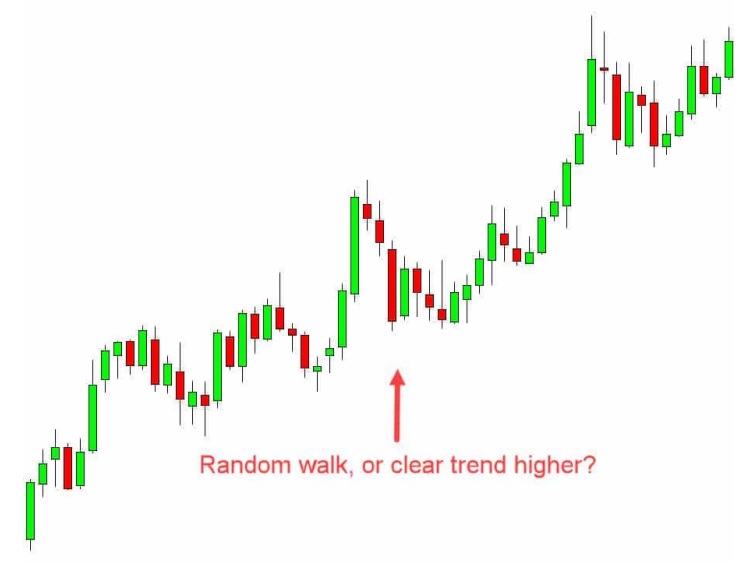The reliability of the random walk theory has been contested for many years. However, a thorough understanding of how this theory works can improve your trading tactics. The foundations of the random walk theory are covered in detail, along with some of its useful trading applications.
Table of Contents
- An Overview of the Random Walk Theory
- The Correlation between the Random Walk Theory and Efficient Market Hypothesis
- Practical Applications of the Random Walk Theory in Finance
- How to Integrate the Random Walk Theory into Your Trading Methodology
- Real-life Instances of the Random Walk Theory in Practice
- Conclusion
An Overview of the Random Walk Theory
Although traders have been debating the random walk theory for many years, Jules Regnault is credited with having first proposed it in his book published in 1863. Since then, many investigations and discussions have been made, from Paul Cootner’s 1964 book “The Random Character of Stock Market Prices” to Louis Bachelier’s dissertation on the philosophy of speculation. Burton Malkiel, a professor at Princeton University, popularized the phrase “random walk” in his 1973 book “A Random Walk Down Wall Street.”
The argument holds that market prices fluctuate arbitrarily and that there are no obvious patterns or trends that traders can take advantage of. This article investigates whether market psychology and trends are predictable over time by testing the validity of the random walk theory.

The Correlation between the Random Walk Theory and Efficient Market Hypothesis
Jules Regnault is credited with introducing the random walk hypothesis in his book released in 1863, while traders have debated it for many years. Since then, other studies and discussions have been conducted, ranging from Louis Bachelier’s dissertation on the philosophy of speculation through Paul Cootner’s 1964 book “The Random Character of Stock Market Prices.” In his 1973 book “A Random Walk Down Wall Street,” Princeton University professor Burton Malkiel is credited with popularizing the term “random walk.”
The claim is that there are no observable patterns or trends that traders can profit from and that market prices fluctuate arbitrarily. This article tests the reliability of the random walk hypothesis to determine whether market psychology and trends are predictable over time.
Practical Applications of the Random Walk Theory in Finance
The random walk theory proponents frequently suggest index funds or diversified stock portfolios for investment. They base their advice on stock market success in the past, which has increased over time despite several crashes. As a result, proponents of this idea think that investing over the long term is the wisest course of action.
Given their belief that markets lack discernible price trends or cycles, random walk traders are also dubious about choosing specific equities and forecasting minute price changes. This point of view, however, is debatable. For instance, in a 14-year experiment undertaken by the Wall Street Journal, expert stock pickers fought against equities that were chosen at random. After 14 years of testing, it was unclear if markets are random or exhibit cycles and tendencies.
The possibility that markets will follow patterns and cycles on which traders can make money with their bets has increased recently. For example, computer programs and trading bots take advantage of these tendencies to place transactions, albeit occasionally for brief periods. Given that these bots may be predicted, trends and cycles may also be, and markets may not be completely random.
How to Integrate the Random Walk Theory into Your Trading Methodology
The best course of action for investors who adhere to the random walk theory and think that markets fluctuate at random would be to invest in managed or index funds. Even when market crashes are taken into account, these funds have produced positive returns over a long period of time. The risks involved in forecasting and timing the markets are reduced by taking a long-term approach.
Technical analysis and chart patterns, on the other hand, are more appropriate tactics for individuals who think that market trends and cycles are cyclical in nature. These traders contend that because of trader psychology, markets move in cycles and frequently repeat themselves. Today’s traders who use chart patterns are well-liked because they think that different patterns disclose the psychology underlying current market movements, enabling them to forecast future price fluctuations and place lucrative trades.
Real-life Instances of the Random Walk Theory in Practice
Many people hold the view that markets exhibit patterns and may be somewhat forecast, despite the fact that we have only discussed those who subscribe to the random walk theory. Behavioral finance expert Martin Weber is one of many who disagrees with the random walk theory. In order to find trends and cycles and determine whether the markets were predictable during this time, Weber undertook a study that examined stock prices over a ten-year period.
His research showed that markets are frequently predictable. Furthermore, his research demonstrated that stocks that significantly increased in value during the first five years of the research period usually underperformed during the following five years. This finding suggests that certain trading tactics can make markets predictable.
Conclusion
The random walk theory has been the subject of a protracted discussion, but traders and scholars are proving that markets can be forecast to some extent. These people are demonstrating that numerous tactics can be used to trade markets profitably through various testing and investigations. Trading bots and computers have made money recently by correctly anticipating the markets. Even though these trades are frequently completed in milliseconds, they show that the markets can be forecast and profitably traded using their many cycles and patterns.

